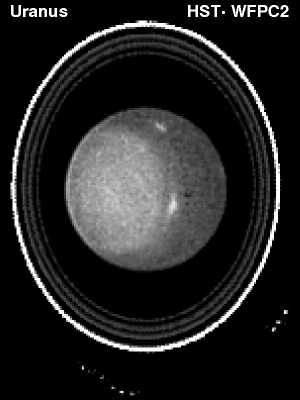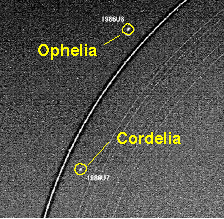The Rings of
Uranus
 The rings of Uranus (and some of its moons) are shown in the adjacent Hubble
Space Telescope image.
The rings were discovered from the Earth in 1977 when Uranus occulted
(passed in front of) a star and it was noticed that there were dips in the
brightness of the star before and after it passed behind the body of Uranus.
The rings of Uranus (and some of its moons) are shown in the adjacent Hubble
Space Telescope image.
The rings were discovered from the Earth in 1977 when Uranus occulted
(passed in front of) a star and it was noticed that there were dips in the
brightness of the star before and after it passed behind the body of Uranus.
This data suggested that Uranus was surrounded by at least 5 rings. Four more
rings were suggested by subsequent occultation measurements from the Earth, and
2 additional ones were found by Voyager 2, bringing the total to 11 (the
adjacent image shows only some of the brighter rings.
Most of the rings are not quite circular, and most are not exactly in the plane
of the equator. The rings vary in brightness with angle around the moon,
apparently because they vary in width with angle.
The rings are very narrow (some only a few kilometers across) and no material
can be detected in the regions between the rings. It is speculated that this
stability of the narrow rings may be due to small "shepherding satellites", as
discussed in conjunction with Saturn's rings.
 The brightest ring is termed the Epsilon ring. Voyager 2 found two small
shepherd moons for it, one just inside and one just outside
(adjacent image
(Ref);
the white dots inside the yellow circles). They appear to be
about 20-30 km in diameter, and have been named Ophelia and Cordelia.
The brightest ring is termed the Epsilon ring. Voyager 2 found two small
shepherd moons for it, one just inside and one just outside
(adjacent image
(Ref);
the white dots inside the yellow circles). They appear to be
about 20-30 km in diameter, and have been named Ophelia and Cordelia.
 The rings of Uranus (and some of its moons) are shown in the adjacent Hubble
Space Telescope image.
The rings were discovered from the Earth in 1977 when Uranus occulted
(passed in front of) a star and it was noticed that there were dips in the
brightness of the star before and after it passed behind the body of Uranus.
The rings of Uranus (and some of its moons) are shown in the adjacent Hubble
Space Telescope image.
The rings were discovered from the Earth in 1977 when Uranus occulted
(passed in front of) a star and it was noticed that there were dips in the
brightness of the star before and after it passed behind the body of Uranus.
